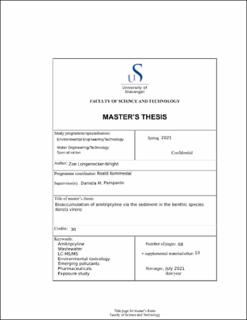| dc.description.abstract | The presence of antidepressants and other pharmaceuticals in micro concentrations in the marine environment have, in recent years, become a focal area for ecotoxicology. These compounds might have unexpected impacts on fish and other aquatic animals despite their seemingly scant presence. The negative consequences caused by bioaccumulation and biomagnification are two notable concerns. In 2019, the SANOCEAN team from the University of Stavanger identified a cocktail of contaminants in a region surrounding the outlet waters of a wastewater treatment plant. One of the compounds found in the sediment samples was from the tricyclic antidepressant amitriptyline. As research had not been done on the bioaccumulation potential of this compound in benthic animals, this thesis was designed around investigating that question. This was done through a 28-day exposure study using the polychaete benthic worm Nereis virens. Three different environmental sediment samples, two laboratory amitriptyline spiked samples (3.057µg/g-sediment and 30.57µg/g-sediment), and one negative control sample were used for the exposure. At the end of the study the concentration of amitriptyline in biota, sediment, and water was analyzed. After the 28 days of exposure, there was a clear indication of accumulation in the biota. In the sediment samples collected from a reference area (assumed to be a clean location) the level of amitriptyline in the worms was below the limit of detection. In the spiked sediment samples, there was a detectable amitriptyline level with a mean average of 9.5ng/g-biota and 56.5ng/g-biota for the low and high spiked concentration respectively. This is indicative of bioaccumulation. The speed and level of this accumulation as well as the impact that it could have on the food chain and aquatic environment are further research suggestions as well as amitriptyline’s biological effects on Nereis virens. | |
